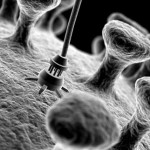
www.h20technologies.com
In the call for studies on the health and safety of nanoparticles in various uses, it is easy to overlook important questions about what the studies mean. Does a study demonstrating what may be considered an adverse outcome provide a basis for legal action? The complex answer is, “Sometimes yes and sometimes no,” or in the words of every law professor, “It depends.”
Let’s take a look a highly publicized study published in late 2009. See Trouiller et al., Titanium Dioxide Nanoparticles Induce DNA Damage and Genetic Instability In vivo in Mice, CANCER RES. 2009; 69: (22), Nov. 15, 2009. Researchers from UCLA conducted a study in vivo on mice to test the effects of the titanium dioxide nanoparticles, regularly used in many consumer products, including cosmetics (especially sunblocks), food coloring, toothpaste, and paint. The researchers herald their study as the first in vivo study to demonstrate a connection between the particular substance and genetic harm. Previous in vitro studies, they say, produced mixed results and by their very nature did not involve living tissue.
First, a word about how the law views in vitro and in vivo studies. In vitro studies, such as the Ames test, test the effects of chemicals on bacteria or other cells in a laboratory dish, looking for genetic mutations. These studies are sometimes offered in a legal setting to suggest that exposure to the substance is carcinogenic in human, on the theory that somatic cell mutations lead to uncontrolled cell reproduction and, ultimately, cancer. In vivo studies compare laboratory animals exposed to a particular substance to a control group that was not exposed, looking for differences in outcomes between the two groups. What both types of studies have in common is that they do not involve humans. As a result, they also have in common the need to extrapolate from the test data to predictable results in humans, a process that is speculative. In other words, both studies fall short of demonstrating exactly what will happen when humans are exposed to the substance. But both are relatively fast, inexpensive, and do not involve the ethical dilemmas of testing on humans.
Courts bristle when plaintiffs seek to introduce this kind of evidence, without anything else, in personal injury litigation as proof that exposure to a particular substance caused their illnesses. The role of courts in determining what evidence is admissible under the rules of evidence is designed to keep frivolous suits from consuming resources and from reaching juries, which might be more impressionable than the court. Regulators are less constrained than courts, however. The role of government regulators is circumscribed by the legislation giving them authority.
In the scheme of things, the law prefers in vivo studies to in vitro studies because in vivo studies demonstrate some action of the substance on mammalian living tissue. But both types of studies are a distant second to epidemiological studies on human populations. Such statistical studies of risk factors examine groups of humans to determine the strength of relationships between exposures and outcomes. But even they do not examine the direct impact of the substance on human tissues.
All scientific and statistical studies used to demonstrate carcinogenicity serve to demonstrate the difficulty the law has with understanding and using the studies to make legal decisions. In the important U.S. Supreme Court case of Daubert v. Merrell Dow Pharmaceuticals, 509 U.S. 579 (1993), in which the Court provided guidance on determining the reliability of scientific studies in the federal courts (in the context of a toxic torts case involving the prescription drug Bendectin), the Court had the following to say about the distinctions between science and litigation:
[T]here are important differences between the quest for truth in the courtroom and the quest for truth in the laboratory. Scientific conclusions are subject to perpetual revision. Law, on the other hand, must resolve disputes finally and quickly. The scientific project is advanced by broad and wide-ranging consideration of a multitude of hypotheses, for those that are incorrect will eventually be shown to be so, and that in itself is an advance. Conjectures that are probably wrong are of little use, however, in the project of reaching a quick, final, and binding legal judgment – often of great consequence – about a particular set of events in the past.
Id. at 596-97.
There is strength in numbers, however. The more reliable studies that are conducted showing similar results, the more likely the substance will be regulated effectively. And the more likely litigants will be able to assemble a package of expert scientific evidence that will support their positions.
An abstract of the article may be found at http://cancerres.aacrjournals.org/cgi/content/abstract/69/22/8784

this post is very usefull thx!
Terrific work! This is the type of information that should be shared around the web. Shame on the search engines for not positioning this post higher!
It’s hard to believe that this industry goes unregulated and has grown so quickly with no oversight what so ever. When will we learn not to repeat these same mistakes over and over again? Large chemical, food and pharmaceutical companies exist only to generate profit for share holders even if hundreds or even thousands die as the result.
In vivo is the correct way for the law to look upon the testing. One must prove out the theories using this method first before committing to expanding testing into the more ‘human’ aspects.